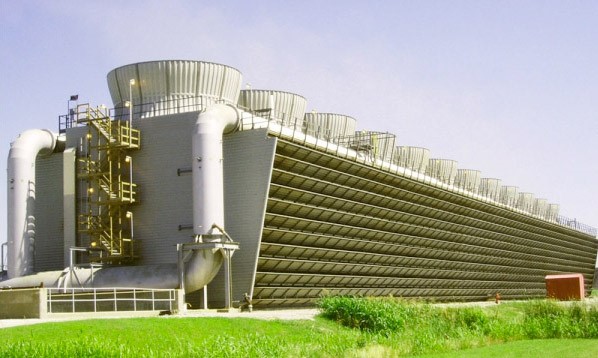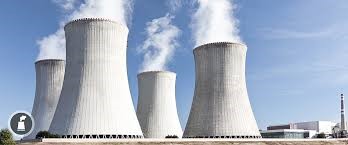Cooling towers are very important part of any chemical process industries. It supplies cooling water to Condensers, Coolers and Jackets of Reactors / Vessels to remove the heat. So, fundamentally cooling towers are direct contact type heat exchangers. In which hot water from plant returns to tower and comes in contact with the air. And, hot water cools down via small amount of water evaporation into the air. This cold water continuously keep on circulating cross the plant to remove heat. In this article we will discuss cooling tower working and it’s types.
Table of Contents
Mainly there are three types of Cooling Towers
Natural Draft Cooling Towers
It consists a tall chimney. Warm, moist air naturally rises due to the density differential compared to the dry, cooler outside air. Warm moist air is less dense than drier air at the same pressure. This moist air buoyancy produces an upwards current of air through the tower.
Mechanical Draft Cooling Towers
Uses power-driven fan motors to force or draw air through the tower.
Induced draft — A mechanical draft tower with a fan at the discharge (at the top) which pulls air up through the tower. The fan induces hot moist air out the discharge. This produces low entering and high exiting air velocities, reducing the possibility of re-circulation in which discharged air flows back into the air intake. This fan/fin arrangement is also known as draw-through.
Forced draft — A mechanical draft tower with a blower type fan at the intake. The fan forces air into the tower, creating high entering and low exiting air velocities. The low exiting velocity is much more susceptible to re-circulation. With the fan on the air intake, the fan is more susceptible to complications due to freezing conditions. Another disadvantage is that a forced draft design typically requires more motor horsepower than an equivalent induced draft design. The benefit of the forced draft design is its ability to work with high static pressure. Such setups can be installed in more-confined spaces and even in some indoor situations. This fan/fin geometry is also known as blow-through.
Fan Assisted Natural Draft – A hybrid type that appears like a natural draft setup, though a fan assist the desired airflow.
Below are most commonly used cooling towers
Induced Draft Crossflow Cooling Tower

Natural Draft Cooling Tower

Specifications for Cooling Tower
Cooling tower sizing needs below information:
- Heat load on cooling tower (kcal/h, TR)
- Dry bulb and wet bulb temperatures
- Water quality (i.e., TDS, TSS, pH)
- Cooling water supply and return temperatures
Typical installation of Cooling Tower

Cooling Tower Working
For an efficient plant operation effectiveness of cooling tower is very important. During cooling tower operation operator should monitor and record below parameters:
- Dry bulb and wet bulb temperatures
- Cooling tower supply and return temperatures
- Cooling water quality (i.e., TDS & pH levels), very important parameter the desired TDS should be in the range of 1000-1200 ppm & pH should be between 6.5 to 7.5.
- Blowdown is required to control the TDS level of circulating water, otherwise it will increase the choking frequency of the equipment because of fouling. This will reduce heat transfer coefficient and effectiveness of the heat exchanger.
- To maintain the TSS (total suspended solids) in circulating water side stream filters very important. Again, TSS will leads to fouling problems in our heat exchangers.
- For effective cooling tower working, regular make up is very important. Because of Drift loss, Evaporation loss and Blowdown the level of cooling water will be keep of decreasing continuously. So to maintain the constant amount of water in cooling tower circulation system cooling water makeup is very important. Automation of make up water to the cooling tower is a good idea for stable operation.
Effectiveness Measures for Cooling Tower
Cooling Tower Range ‘(R):
Cooling tower range is the difference between cooling tower supply and return temperature. Generally cooling towers are designed for 8-10 degC range.
Range (R)= Cooling Tower Return Temperature – Cooling Tower Supply Temperature
Cooling Tower Approach (A):
Cooling tower approach is the difference between cooling tower supply and wet bulb temperature. Generally cooling towers are designed for 2-3 degC approach.
Approach (A) = Cooling Tower Supply Temperature – Wet Bulb Temperature
Cooling Tower Effectiveness (CE):
Cooling tower effectiveness is the given as below
CE = R * 100 / (R + A)
Generally, in practice cooling tower effectiveness are in the range of 65-70%.
Operating Cost Reduction Opportunities in Cooling Tower
Cost contributors in the cooling tower working are as follows:
Electric Power
Power is required for circulation pumps is major contributor in operating cost. One should study the cooling water distribution network properly. We can provide separate headers for low pressure and high-pressure users, this will reduce the required discharge head of the cooling water pump.
We can see the use of booster pump if few cooling water users are at higher elevation inside the plant. This way we can minimize the overall cooling water pump head.
Cooling tower fan interlock with the cooling tower supply temperature can save good amount of fan power. Based on the supply temperature of cooling water fan will be on/off accordingly. We can provide VFD (variable frequency drives) to regulate the RPM of fan motors. This VFD interlocking with cooling tower supply temperature will regulate the RPM of fan and will bring down power bill.
Cooling tower pumps casing and coating to reduce the skin friction losses. This is more useful for old pumps. There is opportunity to reduce the bill by 5% or so.
Using high efficiency fan blades is also good opportunity to reduce cooling tower power bill.
Cooling Tower Blowdown Treatment
We should see number of cycle to reduce the blowdown quantity which require treatment using RO. Hence monitoring the TDS and controlling the blowdown quantity accordingly is the key to reduce the effluent generation quantity from cooling tower. Moreover, it is very important from the environment sustainability point of view.
To make this process automated we can provide a TDS meter in cooling tower and control valve in blowdown line.
Automation & Digital Transformation
We should provide automation and control in cooling tower operations. This we can do by installing VFDs for fan motors, TDS & pH meter control, control valves in make up and blowdown lines, and provision of cooling water circulation, make up and blowdown flow rates.
Moreover, we can look into digital transformation of cooling towers in our plants. This will provide us real time operating data of cooling tower operation, such as loading of each cooling tower, return and supply temperatures, power consumption, TDS, pH, etc. We can analyze these data to get meaningful decisions to optimize the cooling tower loading. This can save overall operating cost by shutting down the underloaded cooling towers.
Also, we should see to operate it through a Machine Learning Model. Digitize all the parameters (cooling water supply & return temperatures, wet and dry bulb temperatures,
Using above all data a ML Model can be developed, which will operate the cooling tower efficiently and cost-effective manner. This way we can minimize the manual intervention in operations.
Thanks for reading looking for your valuable comments.

